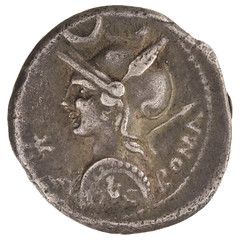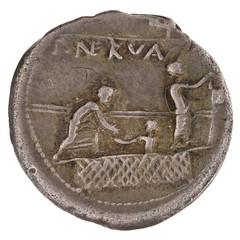
PREV ARTICLE
NEXT ARTICLE
FULL ISSUE
PREV FULL ISSUE
BALLOT BOX ON ROMAN COINThis article discusses voting in Roman times as depicted on a coin, whose image was provided by the American Numismatic Society. -Editor This silver denarius, minted over 2,000 years ago, is hardly the most attractive Roman coin. And yet, the coin is vital evidence for the early stages of a political struggle that culminated in Caesar's assassination and the fall of the Roman Republic. I first encountered this coin while studying Roman history in graduate school. Its unusual design gave me pause – this one depicted figures walking across a narrow bridge and dropping something into a box. I moved on after learning it depicted voting, reasoning that Roman mint officials occasionally made idiosyncratic choices. But as voting access evolves in the U.S., the political importance of this centuries-old coin seems more compelling. It turns out that efforts to regulate voting access go way back. Voting was a core feature of the Roman Republic and a regular activity for politically active citizens. Men, and only men, could vote in multiple elections and legislative assemblies each year. So why would P. Licinius Nerva, the official responsible for this coin, choose to depict such a banal activity? The answer lies in voting procedures that sometimes heavily favored elites.
... written ballots made it more difficult for elites to influence voting but not impossible. Each unit formed its own line leading to a bridge where voters received ballots to mark and place in a basket. Elites could station themselves or their allies on the bridge to encourage people to vote the
In 119 BCE, a young politician named Gaius Marius passed a law that narrowed voting bridge widths, allowing voters to mark their ballots without elites looking over their shoulders. Nerva's coin, minted six or seven years later, almost certainly refers back to this law. By showing only voters on the bridge, Nerva was celebrating an important voting rights victory and announcing his allegiance to Marius. The aristocrats never managed to repeal the voting laws and were still grumbling about them even as the Republic collapsed. The long Roman struggle over voting procedures provides a useful and perhaps even comforting reminder. Changing state voting laws and election lawsuits are nothing new. The fight over voter access to the ballot is an inevitable side effect of democracy.
To read the complete article, see:
Wayne Homren, Editor The Numismatic Bibliomania Society is a non-profit organization promoting numismatic literature. See our web site at coinbooks.org. To submit items for publication in The E-Sylum, write to the Editor at this address: whomren@gmail.com To subscribe go to: https://my.binhost.com/lists/listinfo/esylum All Rights Reserved. NBS Home Page Contact the NBS webmaster 
|


